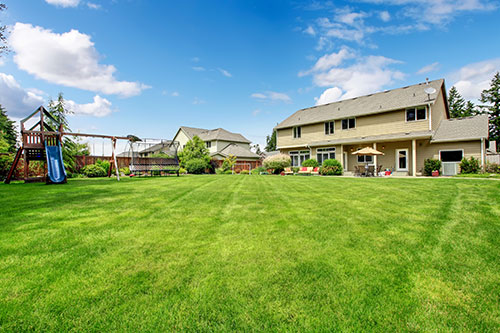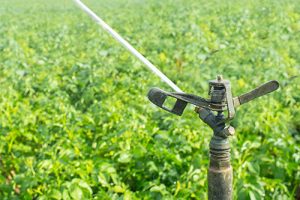How Often To Water Your Lawn In The Summer
Watering your lawn in the summer is one of the most important things you can do to ensure it looks its best even when the thermometer soars. Here we take a look at how to green up a lawn in summer, focusing on the FAQs that homeowners have about keeping their frontage in top condition.
Why is Watering Your Lawn Important During the Summer Months?
 Cool-season grass is the grass of choice used around Kansas City. As the name suggests, this type of grass thrives in the cooler temperatures experienced in the spring and fall. During the summer, these lawns are under both heat and drought stress. This leads to an increased amount of water required to maintain their green color. Improper watering during the summer can lead to brown, dead spots in your lawn and could significantly increase your seeding costs in the fall.
Cool-season grass is the grass of choice used around Kansas City. As the name suggests, this type of grass thrives in the cooler temperatures experienced in the spring and fall. During the summer, these lawns are under both heat and drought stress. This leads to an increased amount of water required to maintain their green color. Improper watering during the summer can lead to brown, dead spots in your lawn and could significantly increase your seeding costs in the fall.
How Frequently to Water Your Lawn With a Sprinkler System?
The first step in determining how much to water your lawn in the summer is to identify what species of grass you have. For example, tall Fescue requires 1 – 1-5″ of water (a combination of irrigation and/or rainfall) per week. In contrast, Kentucky Bluegrass requires up to 2″ of water per week to avoid going dormant. These amounts can increase during hot dry months during the summer. Calibration of your irrigation system by a professional or yourself in the spring will ensure a uniform amount of water is put down with each watering.
Deep, infrequent waterings through the week will encourage extensive root growth. For example, try watering each zone for twenty minutes on Monday, Wednesday, and Friday starting at 6 am.
What To Do If Your Lawn Does Not Have a Sprinkler System?
If you do not have an irrigation system, alternatives can be purchased at your local hardware store and can be easily installed. When buying a hose-end sprinkler, the best products are impact sprinklers (similar to the ones used on golf courses). Research has shown these sprinklers are the best in putting down a uniform and consistent amount of water.
Timers that can attach to your spigot allow you to schedule waterings through the day, as well as attach multiple hoses to one spigot.
What’s the Best Time of Day to Water the Lawn in Hot Weather?
Early mornings are the best time to water the lawn for two reasons:
-
- Watering this early will allow the turf to absorb the majority of the irrigation water and not have it lost due to evaporation caused by the high temperatures in the afternoon.
- Watering early in the morning reduces the amount of time the leaf blade stays wet. If the turf stays wet for long periods of time combined with high temperature and humidity, harmful diseases can develop within the lawn. Diseases may include brown patch and pythium.
How Long Should You Water Your Lawn in the Summer?
Although your first instinct might be to water your lawn every day in the heat of summer with no rain, you actually need to do the opposite! Light, frequent waterings will create shallow roots, reducing the chance of your lawn staying green throughout the summer. It can also increase the chance of disease.
Deep, infrequent waterings spaced out throughout the week will help create deeper root systems that will enable the lawn to reach water deeper in the soil. You should only skip weekly waterings when significant rainfall is in the forecast (greater than 1/2″). Rain sensors can be installed on sprinkler systems to prevent the sprinklers from turning on during rain events.
The number of hours of irrigation required depends on the amount of time it will take for the top 6″ of soil (where the roots are located) to become sufficiently irrigated. Drive a screwdriver into the ground initially to get an idea of how moist the soil is – the screwdriver should easily penetrate to around 6″.
Generally, each square yard will need about five gallons of water each week during the growing season for the grass to thrive.
How To Help Green Up A Lawn In The Summer?
Planning to have a green lawn in the summer begins in the fall. Following proper cultural practices like proper fertilization in the spring and fall will help the lawn develop a deep and extensive root system. This will optimize the chances of the lawn staying green throughout the summer. Watering in the mornings will reduce disease pressure.
My Lawn Has Been Starved of Water While We’ve Been Away – How Can I Green it up Again?
Ideally, the soil needs to be irrigated to a depth of around 6″. If your soil has dried out, we recommend in-depth irrigation for several hours to try and return moisture to the soil. The flow from the sprinkler should be slow to medium, to prevent surface saturation and run-off. A screwdriver can be used to test how far the soil has been sufficiently moistened.
If one session of a few hours has been insufficient, we recommend repeating again in a couple of days, unless the forecast calls for rain, which may do the job for you.
What Time of day is Best to Water Your Lawn if you Can’t Manage Early Mornings?
Although early mornings are the best time, the late afternoon can also work well. It’s important to avoid the heat of the day, as the water on the grass will tend to evaporate, rather than soaking into the soil.
We also don’t recommend watering in the late evening, as this can set up the damp, cool conditions that are ideal for mildew or mold to form.
Alternatives to a Sprinkler System: Can I Water my Lawn Using a Garden Hose?

Water is the one resource that can make or break a lawn. You can have the best yearly program with the best products in the world, but with improper watering, you are throwing money into the ground.
With the unpredictable weather commonly experienced in the midwest, relying on mother nature to water your lawn can lead to disastrous results.
Given all the reasons lawn watering is important, we recommend investing in a suitable sprinkler system.
Contact us to find out more about how to get the very best care for your lawn.









